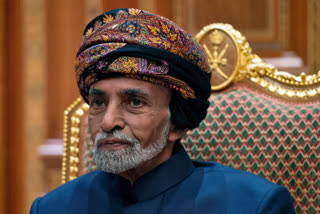Dubai: Oman’s Sultan Qaboos bin Said, the Mideast's longest-ruling monarch who seized power in a 1970 palace coup and pulled his Arabian sultanate into modernity while carefully balancing diplomatic ties between adversaries Iran and the US, has died. He was 79.
The state-run media Agency announced his death late Friday on its official Twitter account. The sultan was believed to have been in poor health in recent months and traveled to Belgium for a medical checkup last month. The royal court declared three days of mourning.
The British-educated, reclusive sultan reformed a nation that was home to only three schools and harsh laws banning electricity, radios, eyeglasses and even umbrellas when he took the throne.
Under his reign, Oman became known as a welcoming tourist destination and a key Mideast interlocutor, helping the US free captives in Iran and Yemen and even hosting visits by Israeli officials while pushing back on their occupation of land Palestinians want for a future state.
“We do not have any conflicts and we do not put fuel on the fire when our opinion does not agree with someone,” Sultan Qaboos told a Kuwaiti newspaper in a rare interview in 2008.
The sultan’s death, however, raises the risk of unrest in this country on the eastern edge of the Arabian Peninsula. The unmarried Sultan Qaboos had no children and did not publicly name an heir, a tradition among the ruling Al Said dynasty whose history is replete with bloody takeovers.
Read more:British oil tanker spotted at UAE port after Iran release
Oman’s longtime willingness to strike its own path frustrated Saudi Arabia and the United Arab Emirates, longtime foes of Iran who now dominate the politics of regional Gulf Arab nations. How Oman will respond to pressures both external and internal in a nation Sultan Qaboos absolutely ruled for decades remains in question.
“Maintaining this sort of equidistant type of relationship ... is going to be put to the test," said Gary A. Grappo, a former US ambassador to Oman. "Whoever that person is going to have an immensely, immensely difficult job. And overhanging all of that will be the sense that he's not Qaboos because those are impossible shoes to fill.”
The sultan had been believed to be ill for some time, though authorities never disclosed what malady he faced. A December 2019 report by the Washington Institute for Near-East Policy described the sultan as suffering from “diabetes and a history of colon cancer.”
Sultan Qaboos spent eight months in a hospital in Germany, returning to Oman in 2015, with the royal court only saying that the treatment he received was successful. In December 2019, he travelled to Belgium for a week for what the court described as “medical checks.” Days of worry about his condition ended Dec. 31, 2019, with the royal court describing him to be in stable condition.
Sultan Qaboos cut a fashionable figure in a region whose leaders are known for a more austere attire. His colourful turbans stood out, as did his form-fitting robes with a traditional curved khanjar knife stuck inside, the symbol of Oman. He occasionally wore a white turban out of his belief that he spiritually led Oman’s Ibadi Muslims, a more liberal offshoot of Islam predating the Sunni-Shiite split.
The sultan's willingness to stand apart was key to Oman's influence in the region. While home only to some 4.6 million people and smaller oil reserves than its neighbours, Oman under Sultan Qaboos routinely influenced the region in ways others couldn't.
Oman's oil minister routinely criticizes the policies of the Saudi-led OPEC oil cartel with a smile. Muscat hosts meetings of Yemen's Houthi rebels, locked in a yearslong bloody war with Saudi Arabia. When Americans or dual nationals with Western ties are detained in Iran or areas under Tehran's influence, communique that later announces their freedom routinely credit the help of Oman.
The sultan's greatest diplomatic achievement came as Oman hosted secret talks between Iranian and US diplomats that led to the landmark 2015 nuclear deal between Tehran and world powers limiting Iran's atomic program in exchange for the lifting of economic sanctions. Yet even then, the sultan maintained ties to those in the Pahlavi dynasty that Iran's 1979 Islamic Revolution overthrew.
Sultan Qaboos' outward-looking worldview could not have contrasted more sharply than that of his father, Sultan Said bin Taimur, under whose rule the sultanate more resembled a medieval state. Slavery was legal, no one could travel abroad and the music was banned. At the time, the country, which is nearly the size of Poland, had only 10 kilometres (6.21 miles) of paved roads.
